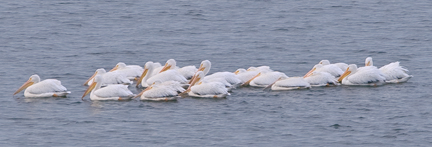
Migration time for white pelicans
By Stan Kirkland, FWC
One of the many benefits of living in the Florida panhandle and particularly near the coast is the vast variety of wildlife we often see. Daily, you’re apt to see bald eagles, ospreys, fox squirrels, black bears, wild turkeys, deer and numerous other species. It’s all about being in the right place at the right time.
One species you may miss that’s migrating through our area now are white pelicans. Just like a number of other migratory birds, white pelicans leave their summer home in the West and Midwest and head south as winter approaches.
Where our common brown pelican has a 6 ½ -7 ½ foot wingspan, white pelicans have a 9 – 9 ½ foot wingspan. White pelicans are also substantially heavier, weighing up to 17 pounds. Brown pelicans rarely weigh more than four pounds.
Stephen Nesbitt spent 35 years working as a wildlife biologist with the Florida Fish and Wildlife Conservation Commission (FWC). He’s retired now but still does a significant amount of work with the FWC on brown pelicans and bald eagles.
He says white pelicans nest in early summer along freshwater lakes in Northern California, Utah, North Dakota, Kansas, Nebraska, and well into Canada. Unlike the brown pelican, which is a “plunge diver,” white pelicans scoop and eat all sorts of small freshwater fish such as various minnows, suckers, shiners and anything small that’s unfortunate to swim near them.
Nesbitt said it’s in the fall, as temperatures change, that the pelicans begin a southward migration that can lead them to Florida, Louisiana, Texas or even Mexico.
“To be such a big bird they’re fairly light but they have a big wingspan. Like many birds, they migrate following fronts on high pressure. They catch the thermals and they can go forever,” he said.
According to Nesbitt, the white pelicans that end up in Florida likely follow the Mississippi River to the Gulf of Mexico, and then head east. He said they’ve probably been coming to Florida for thousands of years.
Nesbitt said typically there’ll be large flocks of wintering white pelicans near Cedar Key on the Gulf Coast, but most spend their winter months on lakes and rivers from the St. Johns River down to the Kissimmee chain of lakes and Lake Okeechobee.
He said one noteworthy characteristic of both white and brown pelicans is they’re sensitivity to harmful chemicals or pesticides in the water. He said they are “the canary in the coal mine” when it comes to dangerous pollutants.
Just a few years ago, several hundred white pelicans and several other species of birds died when they fed on a flooded vegetable farm near Lake Apopka in North Central Florida. The culprit – highly toxic pesticides that lay bound in the soil until the lake was filled.
Around 1960 a similar pesticide spill or case of illegal dumping cost the state of Louisiana virtually all of its brown pelicans, according to Nesbitt. Overnight almost 40,000 pairs of pelicans disappeared. Nesbitt said Florida later played a part in restoring their populations by sending dozens of pairs of birds.
For now, though, look to the sky, particularly to the west, as you drive anywhere along the coast. If you’re lucky enough to see a flock of migrating white pelicans, they’ll typically be 2000-3000 feet high and drifting along in a lazy line, or as they are prone to do, flying in a circle on the thermals.
Their stay here in the Sunshine State in fairly limited. By March or early April they reverse the process and leave Florida behind as they fly back to familiar grounds.
